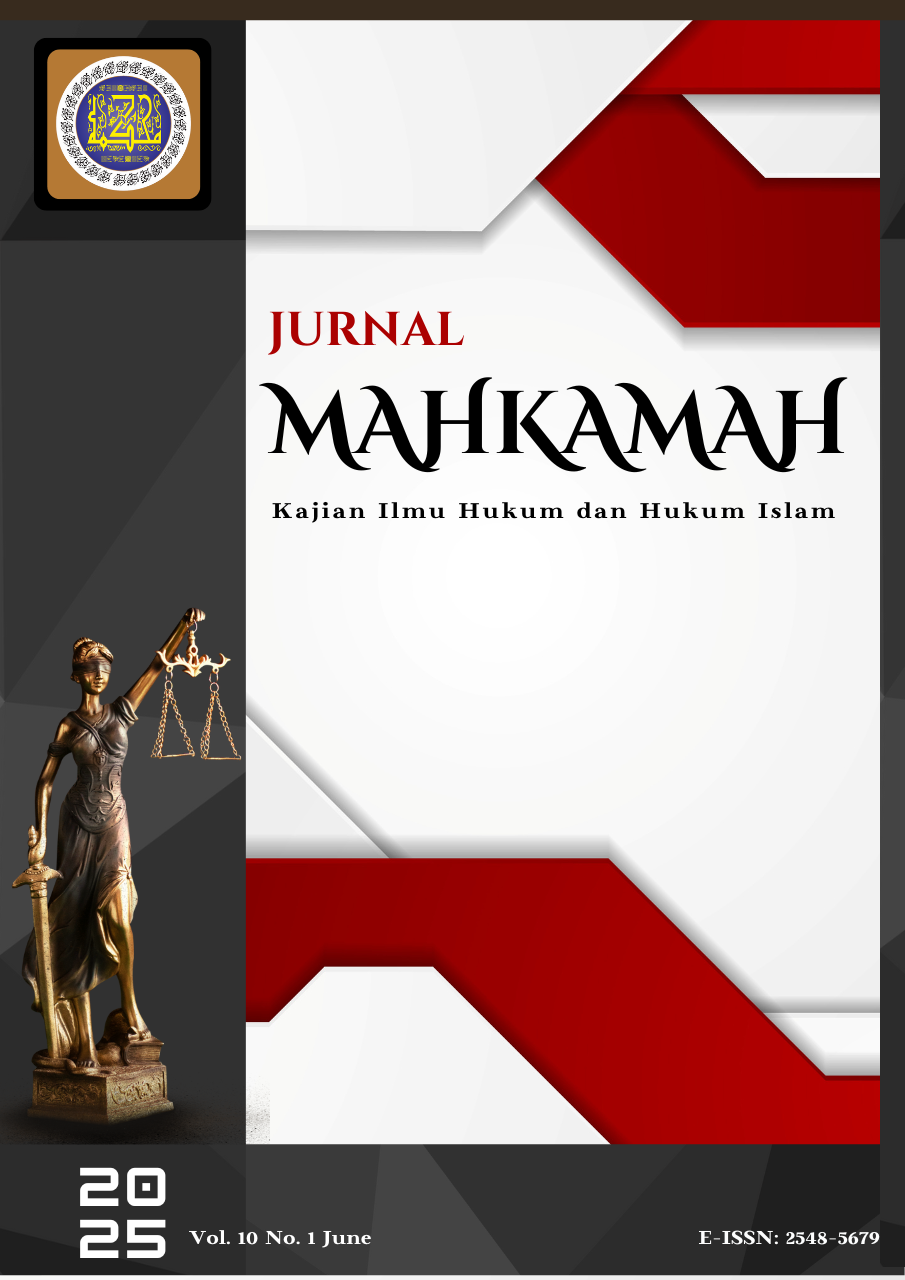Sanctions for Rape Crime in Decision Number 156/Pid.Sus/2020/PN.Pkb. Perspective of Islamic Criminal Law
DOI:
https://doi.org/10.25217/jm.v10i1.6229Keywords:
Sanctions, Crime of Rape, Islamic Criminal LawAbstract
Rape is a serious crime that violates the law and human dignity. However, court rulings, such as Decision No. 156/Pid.Sus/2020/PN.Pkb, often impose light sentences that are not commensurate with the serious impact experienced by the victims. This study aims to examine the chronology of the case, the reasons behind the judge's decision to impose a lenient sentence, the impact of the decision on crime prevention, as well as the elements and penalties for the crime of child rape under the perspective of Islamic Criminal Law. Using a case approach, normative legal methodology, and qualitative data, the data was collected through library research and analyzed using content analysis. This study draws on modern legal theory, the theory of Maqashid Syariah, and the theory of jarimah ta'zir. The findings reveal a significant imbalance between the severity of the criminal act and the leniency of the imposed sanctions, which undermines the objectives of modern legal theory and the theory of Maqashid Syariah. In this case, the defendant was sentenced to six years in prison, despite the applicable law (Article 81(3)) allowing for a maximum sentence of fifteen years. Furthermore, Islamic law does not explicitly stipulate punishment for rape in the Quran, scholars analogize it to the law of adultery as outlined in the Quran, Surah An-Nur, Verse 2. As for the Hadith narrated by Muhammad bin Yahya Al-Naisaburi, it supports similar penalties for rape and adultery, with the main difference being that only the perpetrator is punished.
References
Afifah, F., & Warjiyati, S. (2024). Tujuan, Fungsi Dan Kedudukan Hukum. Jurnal Ilmu Hukum Wijaya Putra, 2(2), 142–152. https://jurnal.uwp.ac.id/fh/index.php/jurnalilmuhukum/article/download/206/75
Apriansya, D. (2019). Penegakan Hukum Terhadap Tindak Pidana Pemerkosaan Terhadap Anak Di bawah Umur Dan Sanksi Yang Diterapkan. Jurnal Panorama Hukum, 4(2), 135–145. https://doi.org/https://dx.doi.org/10.21067/jph.v4i2.3967
Arifin, B. (1992). Tarjamah Sunan Abi Daud (Hadits Nomor 4238). CV Asy Syifa’.
At-Tirmidzi, M. bin I. bin S. (1996). Jami’ul Kabir (Juz 3, Nom). Daar Gharbi Islami.
Benuf, K., & Azhar, M. (2020). Metodologi Penelitian Hukum sebagai Instrumen Mengurai Permasalahan Hukum Kontemporer. Jurnal Gema Keadilan, 7(1), 20–33. https://doi.org/10.24246/jrh.2019.v3.i2.p145-160
Efendi, Y., & Bari, F. (2023). Penerapan Sanksi Pidana Dan Sosial Bagi Pelaku Tindak Pidana Kekerasan Seksual. Hakim: Jurnal Ilmu Hukum Dan Sosial, 1(3), 193–203. https://doi.org/https://doi.org/10.51903/hakim.v1i3.1241
Gunawan, F. H., & Rohmawati, H. S. (2022). Perlindungan Agama Islam terhadap Anak dari Kekerasan Seksual. Equalita: Jurnal Studi Gender Dan Anak, 4(2), 177–189. https://doi.org/10.24235/equalita.v4i2.12903
Hanafi. (2022). The Concept of Understanding Children in Positive Law and Customary Law. VOICE JUSTICIA Jurnal Hukum Dan Keadilan, 6(2), 26–35. https://journal.uim.ac.id/index.php/justisia/article/view/1937/1033
Harahap, N. (2020). Penelitian Kualitatif (Cetakan 1). Wal ashri Publishing.
Irawati, D., & Putra, G. P. (2024). Efektivitas Penegakan Hukum bagi Pelaku pelecehan Seksual pada Anak Ditinjau dari Hukum Pidana. Birokrasi: Jurnal Ilmu Hukum Dan Tata Negara, 2(4), 280–290. https://doi.org/10.55606/birokrasi.v2i4.1663
Iswantoro, W. (2018). Penemuan Hukum Oleh Hakim Dan Implikasi Terhadap Perkembangan Praperadilan. Majalah Hukum Nasional, 48(1), 45–56. https://doi.org/https://doi.org/10.33331/mhn.v48i1.112
Jaya, I. G. N. N., & Saraswati, P. S. (2022). Penerapan Sanksi Pidana Dalam Tindak Pidana Pemerkosaan Terhadap Anak Di Wilayah Hukum Polresta Denpasar. Jurnal Hukum Mahasiswa, 2(2), 370–386. https://doi.org/10.36733/jhm.v1i2
Nasution, A. F. (2023). Metode Penelitian Kualitatif (Cetakan 1). CV Harfa Creative.
Nasution, F. N. (2017). Tinjauan Hukum Islam Terhadap Pemidanaan Anak Pelaku Pemerkosaan Dalam Hukum Positif. SALAM: Jurnal Sosial & Budaya Syar-I, 4(2), 153–202. https://doi.org/10.15408/sjsbs.v4i2.7872
Republik Indonesia. Kitab Undang-Undang Hukum Acara Pidana
Republik Indonesia. Kitab Undang-Undang Hukum Pidana
Republik Indonesia. Undang-Undang Nomor 3 Tahun 1997 Tentang Pengadilan Anak
Republik Indonesia. Undang-Undang Nomor 17 Tahun 2016 Perubahan Atas Undang-Undang Nomor 35 Tahun 2014 Perubahan Atas Undang-Undang Nomor 23 Tahun 2002 Tentang Perlindungan Anak
Republik Indonesia. Undang-Undang Nomor 23 Tahun 2002 Tentang Perlindungan Anak
Republik Indonesia. Undang-Undang Nomor 35 Tahun 2014 Tentang Perubahan Atas Undang-Undang Nomor 23 Tahun 2002 Tentang Perlindungan Anak
Republik Indonesia. Putusan Pengadilan Negeri Pangkalan Balai Nomor Perkara 156/Pid.Sus/2020/PN.Pkb.
Sari, K. I. P., Farida, L. N., Prameswari, V. E., Khayati, N., Maidaliza, Asmaret, D., Pramana, C., Ramadani, I., Meinarisa, Girsang, B. M., Alfianto, A. G., & Suminah. (2022). Kekerasan Seksual. Cv Media Sains Indonesia.
Setiawan, I. (2018). Tindak Pidana Perkosaan Dalam Tinjauan Hukum Pidana Indonesia. Jurnal Imiah Galuh Justisi, 6(2), 125–137. https://doi.org/10.25157/jigj.v6i2.1716
Solikin, N. (2019). Hukum, Masyarakat dan Penegakan Hukum (Cetakan 1). CV Penerbit Qiara Media.
Sururie, R. W. (2023). Putusan Pengadilan. CV Mimbar Pustaka.
Ulfah, M., Chindy Maghvirani, R., & Lubabin Nuqul, F. (2024). Analisis dampak Korban Kekerasan Seksual pada Anak: Systematic Literatur Review. Jurnal Ilmu Pendidikan Dan Psikologi, 2(1), 46–56. https://journal.pipuswina.com/index.php/jippsi/about
Ulya, N. H. (2021). Perlindungan Hukum Terhadap Anak Korban Kekerasan Seksual Perspektif Negara Dan Maqashid Syariah. Journal of Islamic Law and Family Studies, 4(1), 2622–3015. https://doi.org/10.18860/jifas.v4i1.11839
Wahyuni, F. (2017). Bunga Rampai Hukum Pidana Islam di Indonesia (Cetakan 1). Trussmedia Grafika.
Yava Dwilestari, I., Pawennai, M., & Arif, M. (2024). Efektivitas Penerapan Ancaman Sanksi Pidana Terhadap Pelaku Kekerasan Seksual Terhadap Anak. Journal of Lex Philosophy (JLP), 5(2), 487–503. https://pasca-umi.ac.id/index.php/jlp/article/view/1809/2109
Zaki, M. (2014). Perlindungan Anak Dalam Perspektif Islam. ASAS, 6(2), 1–15. https://doi.org/https://dx.doi.org/10.15642/islamica.2009.4.1.143-153
Downloads
Published
How to Cite
Issue
Section
License
Copyright (c) 2025 Fajar Ichsan Kusuma, Syahrul Anwar, Deden Najmudin

This work is licensed under a Creative Commons Attribution-ShareAlike 4.0 International License.
This work is licensed under a Creative Commons Attribution-ShareAlike 4.0 International License.
Authors retain copyright and grant the Jurnal Mahkamah : Kajian Ilmu Hukum Dan Hukum Islam right of first publication with the work simultaneously licensed under a Creative Commons Attribution License (CC BY-SA 4.0) that allows others to share (copy and redistribute the material in any medium or format) and adapt (remix, transform, and build upon the material) the work for any purpose, even commercially with an acknowledgment of the work's authorship and initial publication in Jurnal Mahkamah : Kajian Ilmu Hukum Dan Hukum Islam.
Authors are able to enter into separate, additional contractual arrangements for the non-exclusive distribution of the journal's published version of the work (e.g., post it to an institutional repository or publish it in a book), with an acknowledgment of its initial publication in Jurnal Mahkamah : Kajian Ilmu Hukum Dan Hukum Islam.
Authors are permitted and encouraged to post their work online (e.g., in institutional repositories or on their website) prior to and during the submission process, as it can lead to productive exchanges, as well as earlier and greater citation of published work (See The Effect of Open Access).








